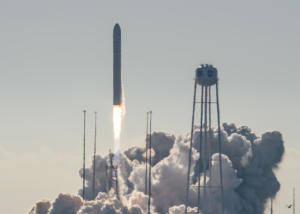Antares NG-12 Resupply Mission Launches on 19th Anniversary of Space Station Inhabitation
 A Northrop Grumman Antares rocket with Cygnus resupply spacecraft onboard launches from Pad-0A of NASA’s Wallops Flight Facility in Virginia Nov. 2, 2019. Credits: NASA/Bill Ingalls
A Northrop Grumman Antares rocket with Cygnus resupply spacecraft onboard launches from Pad-0A of NASA’s Wallops Flight Facility in Virginia Nov. 2, 2019. Credits: NASA/Bill Ingalls

A Northrop Grumman Antares rocket with Cygnus resupply spacecraft onboard launches from Pad-0A of NASA’s Wallops Flight Facility in Virginia Nov. 2, 2019. Credits: NASA/Bill Ingalls
THE SPACE FOUNDATION
WALLOPS ISLAND, Virginia (Nov. 2, 2019) — Under a piercing blue sky and the shelter of a bright white tent Saturday, Terry Feehan had one question for the crowd before him: “Are you ready to RUMBLE?”
The question took on an entirely different connotation coming from Feehan, a retired Air Force major general and now vice president of Safety and Mission Assurance for Launch Vehicles with Northrop Grumman. The newest Antares rocket stood less than 2 miles away at the Virginia Mid-Atlantic Regional Spaceport’s Launch Pad 0A at NASA’s Wallops Flight Facility in Virginia.
Packed inside the rocket base: 162,000 pounds of fuel and 440,000 pounds of liquid oxygen that, when ignited, thrust the 139-foot-tall rocket toward the International Space Station. Atop the rocket: a Cygnus Spacecraft filled with nearly 8,200 pounds of cargo to resupply the orbiting science facility. At 4:10 a.m. Monday, Cygnus is scheduled to ease alongside the space station. Astronauts Jessica Meir and Christina Koch will operate the robotic arm that will pluck Cygnus from orbit and secure it to the station. It’s the 12th Antares rocket Northrop Grumman has launched under contract for NASA and offers the biggest payload and most powerful iteration yet.
Saturday’s launch marked 19 years to the day that astronauts began staying on the station. Pete Hasbrook, an associate program scientist for the space station, offered some perspective. A quarter of the world’s population is 18 or younger, meaning they have never known a time when humans were not living and working in space. In those years, orbiting about 250 miles above the planet and traveling at 17,500 miles an hour, the space station has been the operating base for more than 2,700 experiments involving 4,000 scientists in 108 countries. Those experiments have resulted in more than 1,700 scientific papers. The technology and research from the space station have transformed daily life on Earth but are also helping build a foundation for an extraterrestrial future open to vacationers and humans willing to establish the first outposts in space.
Some of Cygnus’ cargo provided evidence of the adjustments being made as long-range occupations in space become routine: a new treadmill for astronauts, who lose bone and muscle mass more quickly in space than on Earth. Also on board, a zero-gravity oven. Its immediate purpose: to determine how to bake in microgravity. Its eventual use: allowing a hotel chain to provide the warm baked chocolate chip cookies that will one day welcome space travelers as they do on Earth.
More than 30 experiments are being supported through the Antares NG-12 mission, and with improved telemetry and systems, some are being conducted while the Cygnus travels to the space station. Data is being sent back to scientists on Earth during flight. Once cargo is taken from Cygnus, the module will be loaded with trash from the space station that will burn upon re-entry into Earth’s atmosphere. As it leaves the station, the multipurpose Cygnus will deploy several cubesats.
Another experiment also focuses on waste reduction. The Made In Space recycler has used 3-D printing in space since 2016 to create parts and other necessary equipment in space. The advantage, Hasbrook says, is that the printer reduces the need to bring new parts from Earth. The experiment will determine what materials best process, melt and re-process into 3-D printing filament, further reducing waste.
One experiment will help delve into the very nature of the universe. For eight years, the Alpha Magnetic Spectrometer-02 has searched for dark matter and anti-matter, believed to make up four-fifths of the universe. To better understand the universe and how it formed, subatomic positrons must be studied in space. They do not make it through Earth’s atmosphere, explained Bryan Dansberry, an assistant program scientist for the space station’s program science office. Once Cygnus delivers equipment, astronauts on board the space station will do a series of walks to replace fluid lines on the spectrometer. The more positrons and electrons can be studied in space, the more knowledge scientists will have to test theories about dark matter and the universe, Dansberry said.
On Saturday at 9:59 a.m. EDT, those details were not top of mind for the hundreds of spectators who gazed toward the rocket. The crowd had counted down the last five seconds to the launch and began to cheer as billowing gray exhaust shot forth. An orange plume of burning fuel lifted the rocket, suspending it in midair momentarily before the launch vehicle began its climb skyward. Sound waves rolled across the marsh, thumping against the chests of those who gathered, offering the slightest hint of the forces at play. In less than 9 minutes, the Cygnus was fully separated from the Stage 1 of the rocket and was heading toward the space station, leaving only a bright, curling plume of white against a clear blue sky.
Related Resources
- Japanese Billionaire Caps Record Space Tourism Year
- U.S. Joins Allies in Space Operations ‘Vision’
- State of Space 2022: Industry Enters ‘Era of Access and Opportunity’
- 2019 Space Employment Hit 8-Year High, Launch Activity Reached Decade Growth of 39%, Research from The Space Report 2020 Q1 Analysis Shows